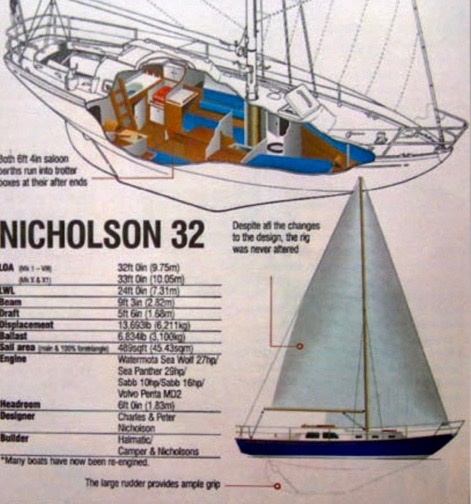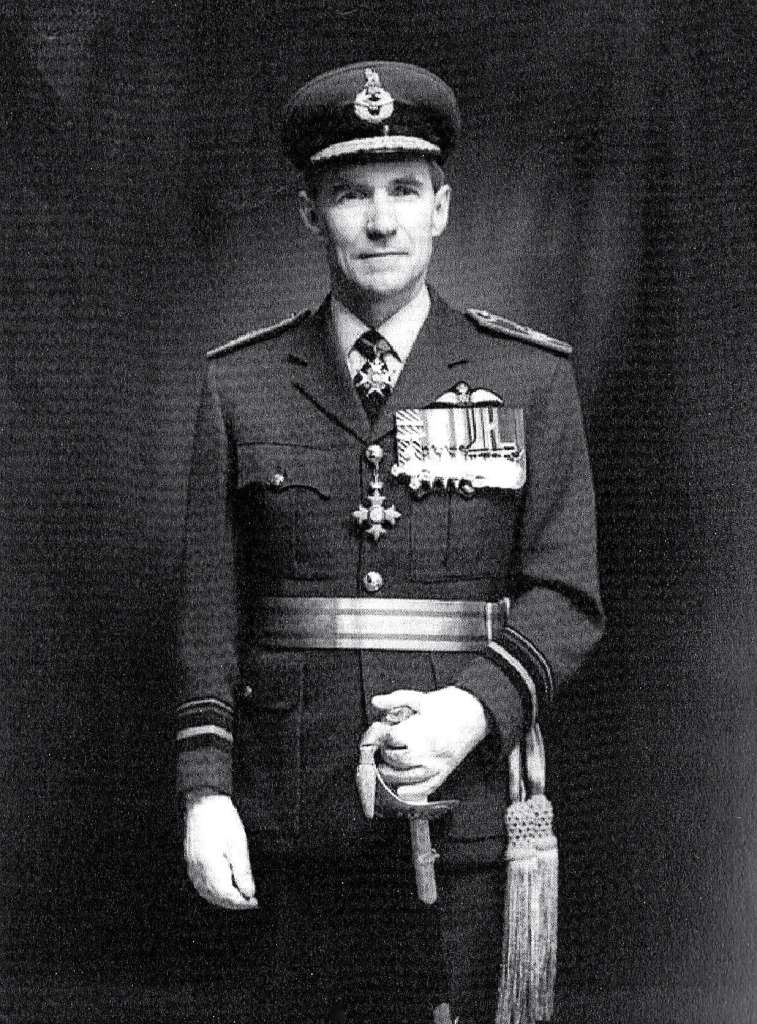I had met Ted at Lymington Yacht Haven in 2004 when I went to view his boat on the hard standing when she was up for sale. Ted had owned Barada for over 30 years and sailed 50,000nm in her. She was a time capsule with old brooks and gatehouse navigational instruments.
Ted was only the second owner and had bought her from a English gentleman in Malta. He’d asked the Royal Navy if they could bring her back on one of their warships but they had told Ted if there was any emergency operational situation they’d have to ditch her overboard.
He thought twice about that but eventually transported her back on a commercial ship. Certainly it does have advantages being high ranking officer in the military but not evidently with RN!
Ted had illustrious career in the Royal Air Force and had been war time pilot of Catalina flying boats. The flying boat arm was called Coastal Command there job was to fly out over the western approaches. However they had sea airbases throughout the UK. Calshot Spit the Solent, Pembroke dock Western Wales, Scapa Flow the Orkney islands and Oban west coast of Scotland. Coastal commands job was to look out for enemy raiders, U-boats or assist the rescue of downed pilots.
He had told me he’d had undertaken a special long trip up to Spitsbergen it was long cold flight but he said it was well worth it for the spectacular scenery when he arrived over his destination, white mountainous scenery surrounded by a green seascape. He had an amazing painting on the wall in his house captured from memory of the aerail landscape of Spitsbergen.
His love of sailing seem to fit in well with his other passion of piloting flying boats. Ted was in the old classical sense an “officer and a gentlemen”, of the stiff upper lipped type, stoic and very understated. You get on with the job in hand no-matter what difficulties you encounter and keep it all to yourself!
Ted seemed delighted when I bought the boat having been ex military and the future plans I had for Barada. Ted gave me some sound advice. “Paul if you look after Barada she’ll always look after you” no truer statement. Sadly Ted passed away 2017 at grand age 97.
Barada is a classic Camper & Nicholson 32 under 10 metres. In modern terms she’s a relatively small sailing boat. Having a long keel she’s designed for long distance ocean sailing. For her size she’s a heavy boat at 7 tonne. Her only draw back is her manoeuvrability or her poor reversing capabilities. It does take awhile to get use to controlling her going astern and keeping her in a some sort of a straight line. That said when she was built in 1964 they didn’t have boat marinas, you anchored or went alongside a quay wall.
But once you get her sails set she soon gets into her groove and you can sail for long distances relatively comfortably. However there isn’t lots space down below because she has quite a narrow beam. But if you’re in heavy weather you can lay a hull or hove to and she sits nicely, slowly moving forward.
Having in-mast reefing enables to reduce sail with out having to turn into wind. That’s great plus in big seas. As the big rollers come in on a downwind situation she just pops up over them like a little cork.
A good few years ago I did run into some bad weather of the north west coast of Spain as I was trying to make Vigo. The weather was on the beam blowing from the north. Sailing in big beam seas at night in complete darkness isn’t to be recommended. Barada was knocked down but she soon popped right back up again. Rosie, my crew mate, found it too difficult to come up on deck. By the time we got to Vigo she was black and blue due to flying pots, pans and having to hang on due to cabin floor being slippy with engine oil residue!
In retrospect having strong northerly winds like that I should have ran down the spanish portugese coast until the weather blow itself out. However we found Vigo to be a real gem. Rosie getting all those awful bruises was all worth it in the end.
For someone with limited financial budget, you pick up NIC 32’s for a song, they’re worth every penny. They’re one tough sailing boat!
 https://youtu.be/naCAhO-4kkQhttps://youtu.be/RQHZOYLB5bA
https://youtu.be/naCAhO-4kkQhttps://youtu.be/RQHZOYLB5bAFew years ago I took a Twin Otter DCH-6 Seaplane from Corfu To Paxos island an amazing flight.
https://youtu.be/ApGUXEQ-nLg
Air Vice-Marshal Ted Hawkins, who has died aged 97, was twice awarded the DFC (Distinguished Flying Cross) for maritime patrol and anti-submarine operations during the Second World War.
After a winter of flying Catalina flying-boats on Atlantic patrols and anti-U-boat sorties with No 240 Squadron, Hawkins was tasked to carry out a top-secret reconnaissance to obtain information about the sea ice between Jan Mayen Island and Spitsbergen Island in the high Arctic.
He was also to report on the state of ice conditions in the fjords of West Spitsbergen and to determine if enemy forces were on the island.
Two passengers accompanied him and his crew when the aircraft left the Shetland Islands on April 4 1942. One was the Norwegian Captain Einar Sverdrup, who knew the area well, and the second was Lieutenant Commander Alexander Glen, an experienced Arctic explorer who would later land on the island to conduct clandestine operations.
Flying through severe weather en route, they were greeted by brilliant sunshine when they reached the edge of the ice to complete their reconnaissance before heading for Spitsbergen. They saw no evidence of the enemy and were able to confirm that sea conditions were suitable for flying-boat operations.
On return to the Shetlands after a flight of 2,000 miles the crew had been airborne for more than 24 hours. Hawkins and his navigator were both awarded the DFC. The citation concluded: “These officers showed great powers of endurance and their outstanding performance is worthy of the highest praise.
The son of a master mariner in both sail and steam, Desmond Ernest Hawkins, always known as Ted, was born on December 12 1919 at Loughton in Essex and was educated at Bancroft’s School.
Leaving school in 1937, he started work as an insurance clerk, but resigned after three weeks. Walking home, he chanced to meet an MP who was also the colonel of the Third Battalion of the London Irish Rifles of the Territorial Army.
Inviting him to join as a rifleman, the colonel recruited him to undertake an undercover intelligence-gathering mission in Germany, Austria and Czechoslovakia during the winter months of 1937-38.
The mission was to infiltrate the Hitler Youth Movement, which could be achieved quite openly by joining the British Youth Hostel organisation, which was affiliated to the Wandershaft of the Hitler Movement. The whole journey was to be carried out on foot.
After formal briefings, Hawkins was taken to Aachen to begin his “long walk” of almost 2,000 miles to Austria, Czechoslovakia and on to Berlin, using German youth hostels and fraternising with the Hitler Youth organisation along the way.
His adventures included sketching Krupps armament works by moonlight, attending a mass rally in Cologne addressed by Hitler himself, being questioned by the suspicious Gestapo (who failed to find the drawings in the lining of his rucksack) and being entertained and debriefed by British ambassadors in Innsbruck and Berlin.
He was then taken by car to Hamburg to join a British cargo ship arriving in London to be debriefed at the end of January 1938.
Two months later he joined the RAF on a short-service commission and trained as a pilot before being assigned to No 1 Anti-Aircraft Co-operation Unit flying a variety of aircraft acting as targets for anti-aircraft units.
After attending a specialist reconnaissance course, he converted to flying-boats before joining No 240 Squadron based in Northern Ireland in September 1941.
After the Arctic sortie the squadron was ordered to fly to Madras to open up a new base. Four aircraft, including Hawkins’s, were detained at Gibraltar in June 1942 to carry out anti-submarine patrols in support of the convoys sailing to Malta.
On June 6 he spotted a surfaced U-boat near the Balearic Islands and he dived to attack. Avoiding heavy anti-aircraft fire he dropped four depth charges. The submarine submerged leaving a large pool of oil on the sea.
It soon resurfaced and was observed settling by the stern. Its crew began to arrive on deck as others jumped into the sea.
Shortly after, the Italian U-boat Zaffiro sank. Hawkins decided to land to pick up survivors and leave life-saving equipment but the heavy swell damaged the Catalina’s hull and he was forced to abandon his rescue attempt and return to Gibraltar. For this attack he was awarded a Bar to his DFC.
Having returned the patched aircraft to the UK for repair, Hawkins and his crew were sent to assist the scattered Archangel convoy PQ 17, going on to alight at Murmansk. From there they joined the hunt for survivors and for the Tirpitz and its escorts – a task he regarded as near suicidal in an aircraft as slow as the Catalina.
A month later, he set off to re-join his squadron in Madras. From August 1942 to October 1944 he flew on convoy escort duties, anti-submarine patrols and special duty operations including dropping agents along the coasts of Burma and Malaya. He was mentioned in dispatches.
After a spell on the air staff in Ceylon, he took command of No 230 Squadron in Singapore, flying the Sunderland on relief operations to isolated garrisons in New Guinea and to repatriate sick PoWs and Dutch internees from Malaya and Java to hospitals in India.
In April 1946 he returned to England to command the flying-boat base in Pembrokeshire before taking charge of the Maritime Aircraft Experimental Establishment at Felixstowe. He was later in charge of administration at RAF Kinloss in Morayshire, one of the RAF’s largest maritime airbases.
He left for Malta in January 1955 to command No 38 Squadron equipped with Shackletons. For his services during the Suez crisis he was again mentioned in dispatches.
After attending the Joint Services Staff College and a tour on the plans staff in the Air Ministry, Hawkins returned to the maritime world as the senior air staff officer at No 19 (Maritime) Group in Plymouth.
In 1964 he took command of RAF Tengah, the RAF’s largest operational base in the Far East – the station complement was some 15,000 people. His Strike Wing of Canberra, Hunter and Javelin squadrons were heavily involved during the Indonesian Confrontation campaign. At the end of his tour he was appointed CBE.
On promotion to air commodore in 1968 he commanded the RAF’s large air transport base, collecting the RAF’s last Hercules C-130K aircraft from the Lockheed factory in the USA.
As an air vice-marshal he was the senior air staff officer at HQ RAF Strike Command at a time when a new generation of combat aircraft were being introduced into service. He was appointed CB in June 1971.
Hawkins spent the last three years of his service before retiring in 1974 as the Director General of Personnel Services (RAF) in the MoD.
He then joined the Services Kinema Corporation as the deputy managing director.
He retired to Lymington in 1981 where he continued his lifelong pursuit of sailing. He was a committee member, captain of cruising, Vice Commodore and finally a Trustee of the Royal Lymington Yacht Club.
AVM Ted Hawkins, born December 12 1919, died October 22 2017
